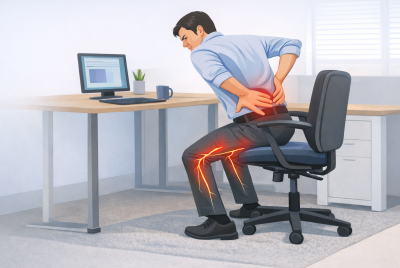Sciatica Ice Packs
Sciatica Ice Packs: Cool Relief For Your Nerve Pain
Discover the power of sciatica ice packs! Dive into quick relief methods, expert tips, and find the best packs for instant pain alleviation. As someone who understands the discomfort and frustration that sciatica can bring, I want to share a valuable tip that may provide you with some much-needed relief: sciatica ice packs. In this article, we will delve into the world of sciatica ice packs, exploring their benefits, how to use them effectively, and other alternative methods to alleviate sciatic nerve pain. So, grab a seat and let’s coolly navigate the path to a more comfortable you!
Understanding Sciatica
Before we dive into the benefits of using ice packs for sciatica, it’s essential to grasp the fundamentals of this condition. Sciatica refers to the pain that radiates along the path of the sciatic nerve, which branches from your lower back through your hips, buttocks, and down each leg. This pain typically occurs when the sciatic nerve becomes compressed or irritated by various factors such as herniated discs, spinal stenosis, or muscle imbalances.
What Is Sciatica?
Sciatica is not a diagnosis in itself but rather a symptom of an underlying condition affecting the sciatic nerve. It often manifests as a sharp, shooting pain that travels from the lower back down to the leg, making everyday activities a challenge.
Causes Of Sciatica
Sciatica can be caused by a multitude of factors, including herniated discs, spinal stenosis, muscle imbalances, pregnancy, obesity, or even prolonged sitting in an improper posture. Identifying the root cause is crucial in developing an effective treatment plan.
Symptoms Of Sciatica
First, let’s talk about what sciatica feels like. Common symptoms include lower back pain, pain in the rear or leg, and even numbness or weakness in various parts of the affected leg and foot. To sum it up, it’s not fun.
Sciatica refers to pain originating from the sciatic nerve, which runs from the lower back down each leg. Symptoms often occur on one side and may include:
Lower Back Pain: Though not always present, some people experience discomfort in the lower back region.
Radiating Pain: Pain usually extends from the lower back or buttock down the leg. It can vary in intensity from mild to severe.
Numbness Or Weakness: This may be felt in the affected leg or foot.
Tingling Sensation: Often described as “pins and needles,” this can occur in the affected leg or foot.
Difficulty Moving: Some people may have difficulty moving the affected leg or foot.
Loss Of Bladder Or Bowel Control: This is rare but could signal a medical emergency known as cauda equina syndrome. Seek immediate medical help.
Ice Pack For Sciatica
Using an ice pack can alleviate sciatica pain. Initially, wrap the ice pack in a cloth to prevent frostbite. Place it on the affected area for 15-20 minutes every hour. Make sure to avoid direct contact between the ice and the skin. This method reduces inflammation and numbs the area, offering temporary relief. Always consult with a healthcare professional before starting any treatment.
How To Correctly Apply Ice To Sciatica Pain
Is Ice Pack Good For Sciatica Pain?
An ice pack benefits sciatica pain, especially during the initial onset. It helps reduce inflammation and numbs the affected area, providing temporary relief. Wrap the ice pack in a cloth to prevent direct skin contact and potential frostbite for best results. Apply it to the painful area for 15-20 minutes every hour. Although ice can offer relief, it’s essential to consult a healthcare professional to address the underlying cause and receive personalized treatment recommendations.
Where To Put Ice Pack For Sciatica?
To relieve sciatica pain, place an ice pack on the affected area. First, wrap the pack in a cloth to protect your skin. Position it over the lower back or the painful area running down your leg. Hold it there for 15-20 minutes every hour. Avoid direct skin contact with the ice to prevent frostbite. This approach can help reduce inflammation and offer temporary relief. Always consult a healthcare professional for guidance.
The Science Behind Using Sciatica Ice Packs
Now, onto the ice packs. The principle is simple: ice packs can provide immense relief for sciatica symptoms when used correctly.
The Role Of Cold Therapy
Cold therapy, also known as cryotherapy, works by reducing inflammation, one of the key culprits of sciatic nerve pain. Imagine an overactive child (inflammation) being calmed down with their favorite toy (the ice pack). It’s the same principle.
Benefits Of Using Sciatica Ice Packs
Ice packs have long been recognized as a valuable tool in reducing inflammation and relieving pain. When applied to the affected area, they can work wonders in easing the discomfort caused by sciatica. Let’s explore some of the key benefits that ice packs offer for sciatic nerve pain relief.
Reduction Of Inflammation And Pain
Ice packs are known for their ability to reduce inflammation by constricting blood vessels and decreasing fluid buildup around the affected area. This constriction of blood vessels helps to alleviate pain by numbing the nerves and reducing the swelling that contributes to discomfort.
Numbing Effect For Immediate Relief
The cold temperature provided by ice packs creates a numbing effect, offering immediate relief from the sharp, shooting pain associated with sciatica. This numbing sensation can provide a respite from the constant ache and allow you to engage in daily activities with greater ease.
Enhanced Blood Circulation
Ice packs stimulate blood flow when applied to the affected area. This increased circulation aids in the natural healing process, as it helps to remove waste products and deliver essential nutrients to the injured tissues. Improved blood flow can accelerate your recovery from sciatica and promote overall healing.
Minimizing Muscle Spasms
Sciatica often goes hand in hand with muscle spasms, which can intensify pain and further restrict movement. Ice packs help relax the muscles, reducing the frequency and intensity of spasms. By applying cold therapy, you can break the cycle of muscle tension and experience increased comfort.
Choosing The Right Ice Pack For Sciatica

Before rushing out to buy an ice pack, remember that not all are created equal.
Factors To Consider
Consider the size, material, and how long it retains the cold. Size does matter here, and you want it to cover the area where you feel the pain. And comfort issues, too, so the material should be soft yet durable.
Top 3 Ice Packs For Sciatica
Well, I can’t exactly tell you which one to buy, but I can surely suggest my top three picks based on customer reviews and my personal experience:
- Chattanooga ColPac – Known for its durability and comfortable material.
- FlexiKold Gel Ice Pack – Praised for its flexibility and cold retention.
- TheraPAQ Ice Pack With Strap – Its strap feature ensures the ice pack stays in place.
Best Ice Pack For Sciatica Pain
The best ice pack for sciatica pain is flexible, covers a large area, and retains coldness. Look for a gel-based pack, as it molds to the body’s contours, ensuring maximum contact with the painful area. Some ice packs come with adjustable straps, allowing you to secure them in place and remain hands-free. Choosing a pack with a durable cover is crucial to prevent leaks. Always wrap the ice pack in a cloth before application to protect your skin from frostbite. Before any treatment, consult a healthcare professional for the most suitable options.
How To Use Ice Packs For Sciatica Effectively
You’ve got the pack, but do you know how to use it properly?
Proper Application
Apply the ice pack to the affected area for 15-20 minutes, then remove it for a similar period. Think of it as a work-rest cycle but for pain relief.
Common Mistakes To Avoid
Don’t apply the ice pack directly to your skin to avoid frostbite. Instead, wrap it in a cloth or towel. And remember, less is more – don’t overdo it.
How To Use Ice Packs For Sciatica
Now that we understand the benefits of ice packs for sciatica, let’s delve into the practical aspects of using them effectively. By following these simple steps, you can maximize the therapeutic potential of ice packs for your sciatic nerve pain.
Choosing The Right Sciatica Ice Packs
When selecting an ice pack, consider one that is pliable and can conform to the contours of your body. Gel-based ice packs are particularly effective, providing flexibility and maintaining a consistent cold temperature throughout the application.
Preparing The Ice Pack
Before applying the ice pack, ensure that it is appropriately chilled. Place the ice pack in the freezer for a recommended duration, typically around 1-2 hours, depending on the specific product’s instructions. Avoid freezing the ice pack solid, which can cause discomfort and potential skin damage.
Applying The Sciatica Ice Packs
To prevent direct contact between the ice pack and your skin, it is crucial to wrap it in a thin cloth or towel. This acts as a protective barrier, preventing potential skin irritation or frostbite. Gently apply the wrapped ice pack to the affected area, holding it in place with light pressure.
Duration And Frequency Of Ice Pack Application
To achieve the desired therapeutic effect, it is recommended to apply the ice pack for approximately 15-20 minutes at a time. However, it is essential to avoid prolonged exposure to cold to prevent any adverse effects. Allow your skin to recover for at least an hour before reapplying the ice pack. Repeat this process several times a day as needed for pain relief.
Precautions And Tips For Using Ice Packs
While ice packs can be incredibly effective in managing sciatica, observing some precautions and following these helpful tips is essential to ensure your safety and maximize its benefits.
Using A Barrier Between The Skin And The Ice Pack
As mentioned earlier, always wrap the ice pack in a thin cloth or towel before applying it to your skin. This layer of protection helps prevent direct contact, reducing the risk of skin damage such as frostbite or burns.
Avoiding Excessive Cold Exposure
While cold therapy can relieve, excessive exposure to cold temperatures can adversely affect your skin and circulation. Remove the ice pack immediately if you experience numbness, excessive redness, or prolonged discomfort, and allow your skin to warm up naturally.
Monitoring Skin Sensitivity
It’s important to pay attention to how your skin responds to cold therapy. If you notice any signs of skin irritation, such as redness, itching, or a rash, discontinue using ice packs and consult a healthcare professional for further guidance.
Combining Ice Pack Therapy With Other Treatments
While ice packs can significantly alleviate sciatica pain, combining them with other treatments can enhance the overall effectiveness. Consider incorporating gentle stretching exercises, heat therapy, or prescribed medications as part of a comprehensive approach to managing sciatica.
Other Remedies And Lifestyle Changes For Sciatica Relief
While sciatica ice packs are fantastic, they work best when used alongside other treatments.
Exercise And Physical Therapy
Specific stretches and exercises can help relieve sciatic nerve pain. Like a good morning routine, establishing an exercise regimen can set the tone for a pain-free day.
Dietary Changes
Did you know that certain foods can increase inflammation? You can further combat sciatica by reducing these and eating more anti-inflammatory foods.
Alternatives To Ice Packs For Sciatica Relief
While ice packs offer an effective and accessible method of relieving sciatica pain, it’s worth exploring other alternatives that may complement your pain management strategy. Here are a few additional approaches you can consider:
Heat Therapy
Therapy, such as using a heating pad or taking warm baths, can relax the muscles, improve blood flow, and provide relief from sciatic nerve pain. Heat can be particularly helpful in easing muscle tension and reducing stiffness associated with sciatica.
What Is Better For Sciatica Heat Or Ice?
Both heat and ice can offer relief for sciatica, but they serve different purposes. Ice reduces inflammation and numbs the affected area, making it effective during the initial onset of pain. On the other hand, heat increases blood flow and relaxes muscles, which can be beneficial for ongoing or chronic sciatica pain. Start with ice for the first 48 hours after the pain begins, then switch to heat. Always consult a healthcare professional for personalized advice.
Stretching And Exercise
Engaging in gentle stretching exercises and low-impact activities can promote flexibility, strengthen muscles, and alleviate sciatica symptoms. Consult with a healthcare professional or a physical therapist to identify suitable exercises tailored to your condition.
Medications And Pain Management
Over-the-counter pain medications or prescribed anti-inflammatory drugs may sometimes be necessary to manage severe sciatica pain. Consult your healthcare provider to determine the appropriate medication and dosage for your specific needs.
What Is The Fastest Way To Cure Sciatica
The fastest way to cure sciatica involves a combination of methods. Immediate relief often comes from applying an ice pack to reduce inflammation. Over-the-counter pain relievers, like ibuprofen, can also ease pain. Engaging in gentle stretches and exercises can release sciatic nerve compression. Maintaining good posture and using ergonomic furniture helps reduce future flare-ups. Physical therapy introduces targeted exercises and techniques to strengthen the back and alleviate pain. In persistent cases, a healthcare professional may recommend treatments like epidural steroid injections. Always consult a doctor for a personalized treatment plan and to ensure the underlying cause gets addressed.
When To Seeking For Medical Advice
If your sciatica symptoms persist or worsen despite home remedies and self-care measures, it is advisable to seek medical advice. A healthcare professional can provide a thorough evaluation and recommend appropriate treatment options tailored to your specific condition.
Frequently Asked Questions (FAQs)
1. How often should I use an ice pack for sciatica?
You can use an ice pack for 15-20 minutes at a time, several times a day, especially when you feel the pain the most.
2. Are there any risks associated with using ice packs for sciatica?
Yes, if used improperly. Always wrap your ice pack in a cloth to prevent frostbite, and don’t apply it for longer than recommended.
3. Can I use a heat pack instead of an ice pack for my sciatica pain?
Some people find alternating between heat and cold therapy effective. However, cold therapy is generally more recommended in the initial days of pain.
4. Will using an ice pack cure my sciatica?
An ice pack won’t cure sciatica but can temporarily relieve acute pain and inflammation. Cold therapy can numb the affected area, reducing pain signals sent to the brain. It’s recommended to apply ice wrapped in a cloth to the affected area for 15 minutes at a time, multiple times a day.
5. Can I exercise while using ice packs for sciatica?
Absolutely! A combination of physical therapy and cold therapy can be very effective in managing sciatica symptoms.
Extra FAQs Related To How To Sciatica Ice Packs
6. Can I apply the ice pack directly to my skin?
No, wrapping the ice pack in a thin cloth or towel before applying it to your skin is important. This helps protect your skin from potential damage or frostbite.
7. How often should I use ice packs for sciatica?
You can use ice packs for sciatica relief several times a day, applying them for approximately 15-20 minutes at a time. Remember to allow your skin to recover for at least an hour between applications.
8. Where to place ice pack for sciatica?
Place the ice pack on the lower back or the painful area running down your leg. Always wrap it in a cloth to protect the skin. Consult a healthcare professional for precise placement and treatment advice.
Sciatica Ice Packs – Conclusion
In conclusion, ice packs can be beneficial for managing sciatica symptoms. Sciatica, caused by compression or irritation of the nerve roots, often results in pain that can worsen with heat application. On the other hand, ice packs relieve pain by numbing the area and reducing inflammation. Applying an ice pack or ice massage for 15 to 20 minutes can help alleviate discomfort, as the cold temperature constricts blood vessels and reduces swelling. Ice therapy is an effective home remedy for sciatica, promoting comfort and potentially improving mobility. However, it is important to remember that individual experiences may vary, and consulting a healthcare professional for a proper diagnosis and personalized treatment plan is always recommended.
There you have it – a comprehensive guide to using ice packs for sciatica. This helps you understand why ice packs are beneficial and how to choose and use one effectively. Pair this with some exercise and dietary changes, and you’re well on your way to managing your sciatica pain.
Disclaimer
Please note that this article should not replace professional medical advice. Consult a healthcare professional for an accurate diagnosis and tailored treatment plan.
👉 Explore more:




